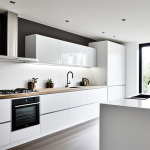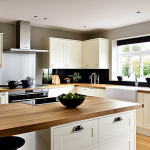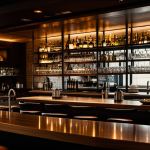Actionable strategies for optimizing restaurant space in the UK
Optimizing space in UK restaurant operations requires a thorough assessment of current space utilization to identify inefficiencies. Many establishments underestimate how much area is wasted through poorly planned layouts or fixed furnishings. Begin by mapping out all functional zones, including dining, kitchen, and service pathways, to pinpoint congestion or underused corners.
Prioritizing multi-functional areas is essential for maximizing flexibility. For example, a waiting area that can convert into additional seating during peak hours enhances overall efficiency. This approach is especially valuable in smaller formats, where every square meter counts. Conversely, larger restaurants benefit from adaptable spaces that accommodate different group sizes or events without the need for costly remodeling.
Also read : How Can You Transform Your UK Kitchen into a Restaurant or Bar Experience?
Adapting space solutions based on restaurant size is fundamental. Small UK restaurants should leverage compact, vertically optimized designs, while larger venues focus on zoning distinct areas to improve flow. Both must consider staff movement to optimize operational speed without compromising guest comfort.
By applying these actionable strategies, UK restaurant operations can transform underperforming spaces into highly efficient environments, ultimately boosting customer satisfaction and profitability. Focusing on flexibility and detailed evaluation are the keys to successful space optimization.
Also read : How Can UK Restaurants Create a Memorable Kitchen Bar Experience?
Actionable strategies for optimizing restaurant space in the UK
Optimizing space in UK restaurant operations starts with a thorough assessment of current utilization. Identifying inefficiencies—like underused corners or overcrowded walkways—allows owners to focus efforts where they matter most. A precise evaluation helps reveal bottlenecks or redundant areas that reduce both guest capacity and staff productivity.
Prioritizing multi-functional areas is crucial for flexibility. Designing spaces that serve dual purposes—such as a bar area converting into a waiting lounge during peak times—maximizes efficiency without expanding the footprint. This adaptability is particularly vital for UK venues constrained by building size or lease conditions.
Adapting solutions differs between small and large formats. Smaller restaurants benefit significantly from compact, versatile furnishings to avoid clutter, while larger establishments can segment zones for specific functions—dining, socializing, or private events—enhancing the guest experience and operational flow simultaneously.
In practice, combining these strategies improves efficiency and customer satisfaction alike. UK restaurant operations that embrace smart space optimization not only increase revenues but also create inviting, dynamic environments adaptable to ever-changing demands.
Effective design layout recommendations for UK restaurants
Designing an efficient restaurant layout plays a crucial role in maximizing floor plan potential and enhancing the overall dining experience. For UK dining spaces, adopting an open-plan concept is a widely recommended strategy. This approach increases seating capacity by reducing physical barriers, promoting better traffic flow and making spaces feel more inviting.
Zoning different areas within the layout accommodates varied guest experiences. For example, distinct zones for dining, waiting, and bar areas help manage customer expectations and allow staff to serve more efficiently. Creating a clear separation between these zones supports both guest comfort and operational effectiveness.
Optimizing pathways is critical for staff efficiency and guest satisfaction. Narrow or convoluted routes can cause bottlenecks that slow service and disrupt the atmosphere. Ensuring direct, unobstructed pathways allows staff to move quickly between the kitchen, dining area, and service stations, minimizing delays and errors. Simultaneously, guest walkways should be wide enough to avoid crowding but designed to encourage a smooth flow.
By carefully considering the layout, UK restaurants can enhance operational speed and create a welcoming dining environment, making the most of available space while maintaining efficiency.
Actionable strategies for optimizing restaurant space in the UK
Optimizing space in UK restaurant operations starts with assessing current utilization to pinpoint inefficiencies. This involves measuring how each zone—dining, kitchen, and service—functions daily to identify underused or congested areas. For example, narrow aisles may hinder staff movement, reducing overall efficiency, while overlooked corners could serve as storage or extra seating niches. To achieve maximum impact, use detailed floor plans and, if possible, digital tools to map usage patterns accurately.
Prioritizing multi-functional areas enhances flexibility without expanding the footprint. Spaces that switch between waiting lounges and additional seating during peak hours improve flow and accommodate higher guest volumes seamlessly. Adaptive furniture complements these areas, allowing quick transformations that align with fluctuating demands, a vital tactic for UK establishments often restricted by lease or property size.
Adapting space solutions also depends on restaurant size. In smaller venues, compact, vertically optimized furniture and clever zoning prevent overcrowding and clutter. Larger restaurants benefit from dividing spaces into zones tailored for different experiences—such as casual dining or private functions—that uphold operational speed and elevate customer satisfaction. This nuanced approach ensures every square meter contributes to heightened efficiency in UK restaurant operations.
Actionable strategies for optimizing restaurant space in the UK
A precise assessment of current space optimization begins with measuring how areas are utilized to identify inefficiencies that undermine efficiency in UK restaurant operations. For example, pinpointing cramped kitchen zones where staff movement is restricted can reveal delays in service flow. Similarly, recognizing underutilized corners supports strategic repurposing to boost guest capacity without expanding the footprint.
Prioritizing multi-functional areas increases flexibility and maximizes use. Converting waiting zones into additional seating during peak times or using modular furniture adaptable for different group sizes directly improves operational flow. This flexibility is key for UK restaurants facing spatial constraints due to historic buildings or lease limits.
Adapting solutions according to restaurant size ensures each format benefits from tailored space strategies. Small venues should embrace compact, vertical solutions and simplify layouts to prevent overcrowding, while larger establishments can implement zoning for diverse experiences—such as private dining or event spaces—that enhance customer satisfaction alongside efficiency.
Ultimately, effective space optimization in UK restaurant operations hinges on detailed evaluation, flexible design, and size-appropriate adaptations, enabling venues to maximize utility and deliver superior service quality.
Actionable strategies for optimizing restaurant space in the UK
A precise assessment of current space optimization begins by mapping how every zone is used throughout the day. Tools like digital floor plans or motion tracking can identify bottlenecks reducing efficiency in UK restaurant operations. For instance, congested service aisles delay orders, while underutilized corners represent missed seating opportunities.
Prioritizing multi-functional areas is vital for maximizing flexibility. Spaces that shift between waiting lounges and extra dining zones during peak times prevent overcrowding and improve the guest experience. Modular or foldable furniture supports this adaptability by allowing easy reconfiguration without additional space.
Adapting solutions to restaurant size boosts effectiveness. Smaller UK venues benefit from vertical storage and compact furniture to avoid clutter, while larger restaurants thrive by zoning spaces like private dining, bar, and event areas to optimize flow and accommodate varied customer needs. This targeted approach ensures every square meter enhances efficiency and overall operation.
Ultimately, focusing on thorough utilization analysis, flexible multi-purpose areas, and size-appropriate adaptations drives successful space optimization in UK restaurant operations, helping venues balance customer comfort with operational speed.
Actionable strategies for optimizing restaurant space in the UK
Achieving effective space optimization in UK restaurant operations starts with a detailed assessment of current utilization to pinpoint inefficiencies. This means carefully measuring the actual use of dining, kitchen, and service areas to uncover bottlenecks or overlooked zones. For example, cramped staff pathways not only impede movement but also reduce overall operational efficiency. Identifying such constraints allows focused redesign efforts that directly improve flow and turnover.
Prioritizing multi-functional areas is another cornerstone strategy. Spaces that convert seamlessly between waiting lounges, extra seating, or event zones increase flexibility without expanding the footprint. Employing modular furniture enhances adaptability, enabling quick adjustments aligned with changing business demands, a necessity amid UK spatial constraints like tight leases or heritage property limitations.
Adapting solutions by restaurant size maximizes impact. Small venues benefit from vertically optimized, compact furnishings that prevent clutter while maintaining guest comfort. Larger establishments should focus on zoning distinct areas for varied experiences—such as casual dining or private functions—that improve operational flow while elevating customer satisfaction. This blended approach ensures every square meter in UK restaurant operations contributes to enhanced efficiency and practical functionality.
Actionable strategies for optimizing restaurant space in the UK
Optimizing space in UK restaurant operations begins with a detailed evaluation of current usage to identify inefficiencies that reduce efficiency. Measuring how dining, kitchen, and service areas function daily pinpoints bottlenecks such as congested aisles or unused corners. For example, staff pathways blocked by fixed furniture hinder speed and increase errors, confirming the need for reconfiguration.
Prioritizing multi-functional areas enhances flexibility and maximizes capacity without expanding the footprint. Spaces that transform between waiting areas, additional seating, or event zones support fluctuating guest volumes common in UK restaurants constrained by building size or lease restrictions. Using modular furniture enables quick changes that keep pace with demand.
Adapting space solutions requires tailoring strategies to the restaurant size. Smaller venues benefit from compact, vertically optimized fixtures that reduce clutter and maximize usable floor area. Larger restaurants excel with clearly zoned sections catering to various functions like casual dining or private events, which improves service flow and guest comfort. This targeted use of space drives operational efficiency and enhances overall customer experience in UK restaurant operations.
Actionable strategies for optimizing restaurant space in the UK
A detailed assessment of current space utilization is essential for effective space optimization in UK restaurant operations. Begin by measuring how each area—dining, kitchen, and service—is used throughout operating hours. For example, identifying bottlenecks such as congested staff pathways or underused corners can pinpoint where efficiency is compromised. Digital tools like motion tracking or timed observations enhance this evaluation, providing precise data to inform improvements.
Prioritizing multi-functional areas boosts flexibility and maximizes the use of limited square meters. Transforming waiting zones into additional seating during peak times or employing modular furniture that adjusts to group sizes allows restaurants to handle fluctuating customer volumes seamlessly. This adaptability not only improves flow but also aligns with varied spatial constraints faced by UK venues, such as lease restrictions or heritage building limitations.
Adapting strategies based on restaurant size is critical. Smaller establishments should focus on vertical storage and compact, versatile furnishings to prevent overcrowding, while larger restaurants can benefit from zoning distinct areas for private dining, bar service, and events. This targeted approach enhances operational efficiency, ensuring every part of the restaurant contributes effectively to overall performance.
Actionable strategies for optimizing restaurant space in the UK
Assessing current space optimization in UK restaurant operations begins with detailed observation and data collection. Measuring how each zone functions throughout busy and slow periods identifies inefficiencies such as bottlenecks or underused areas. For example, cramped aisles can delay staff, while overlooked corners can be repurposed for seating or storage. Utilizing tools like digital floor plans or motion sensors enhances this precision.
Prioritizing multi-functional areas drives flexibility and capacity without physical expansion. Transforming waiting areas into additional seating during peak hours or using modular furniture facilitates quick reconfigurations. This adaptability is crucial for UK restaurants constrained by lease terms or building size, helping them meet variable guest demands efficiently.
Adapting space solutions between small and large restaurants depends on scale and layout. Smaller venues benefit from compact, vertical designs that reduce clutter and maximize usable floor area. Conversely, larger establishments should implement zoning for distinct purposes—such as dining, private events, and bars—to streamline operations and elevate customer experience. Strategic space optimization tailored to property size and workflow directly improves efficiency and profitability in UK restaurant operations.



